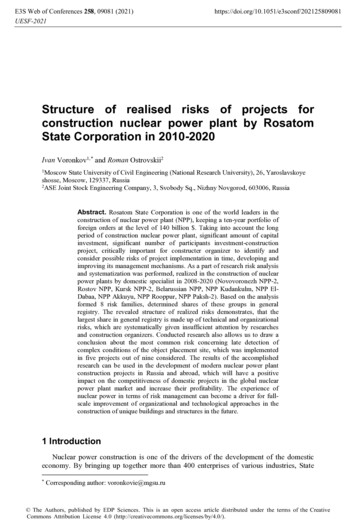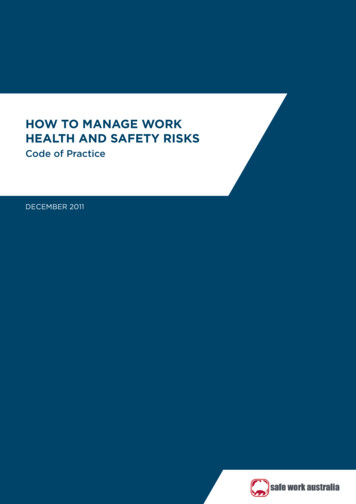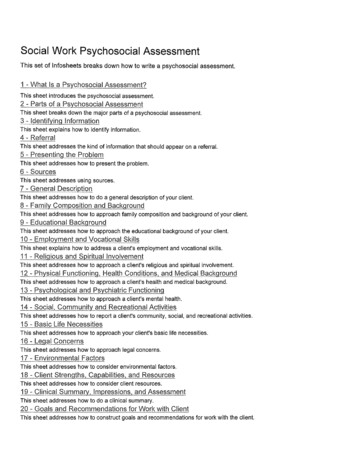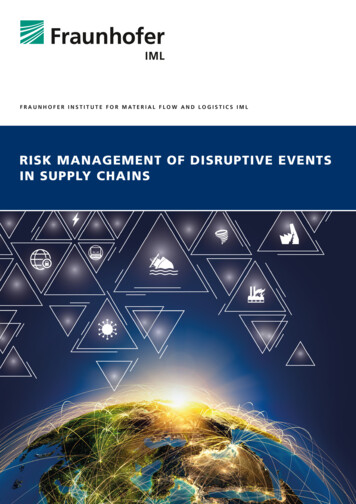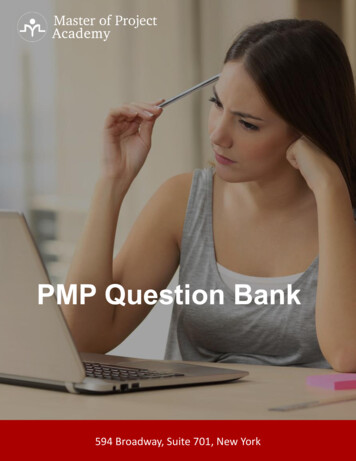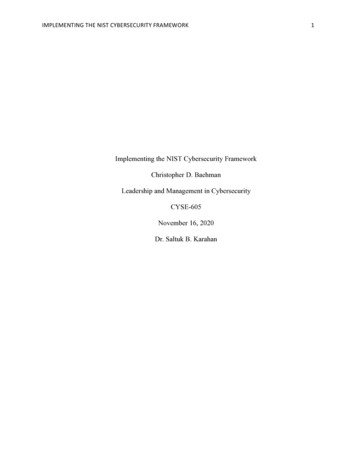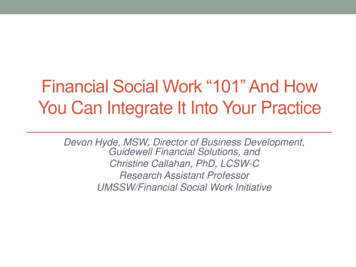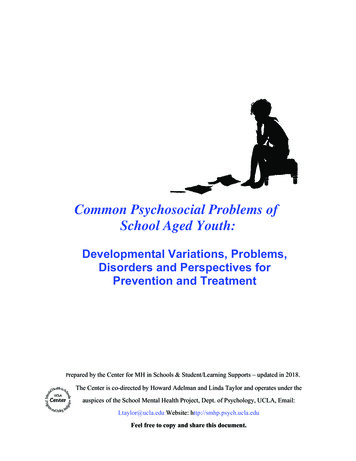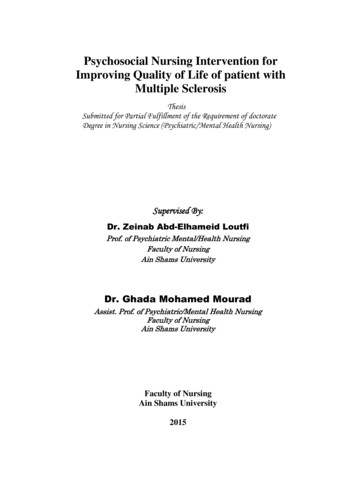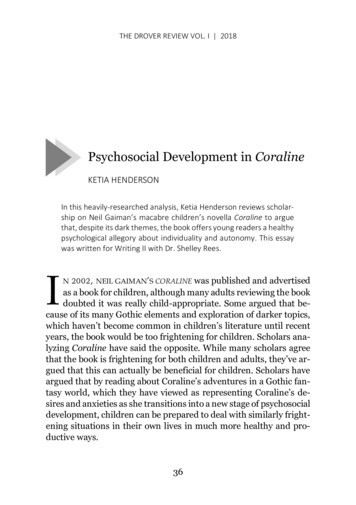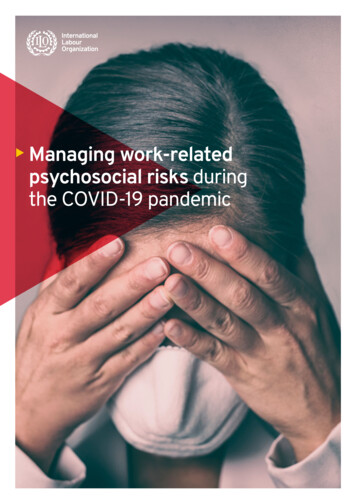
Transcription
Managing work-relatedpsychosocial risks duringthe COVID-19 pandemic
3 Managing work-related psychosocial risks during the COVID-19 pandemicManaging work-relatedpsychosocial risks duringthe COVID-19 pandemic
Copyright International Labour Organization 2020First published 2020Publications of the International Labour Office enjoy copyright under Protocol 2 of the Universal CopyrightConvention. Nevertheless, short excerpts from them may be reproduced without authorization, on condition thatthe source is indicated. For rights of reproduction or translation, application should be made to ILO Publications(Rights and Licensing), International Labour Office, CH-1211 Geneva 22, Switzerland, or by email: rights@ilo.org.The International Labour Office welcomes such applications.Libraries, institutions and other users registered with a reproduction rights organization may make copies inaccordance with the licences issued to them for this purpose. Visit www.ifrro.org to find the reproduction rightsorganization in your country.Managing work-related psychosocial risks during the COVID-19 pandemic - Geneva: ILO 2020.English editionISBN: 9789220323748 (print)9789220323731 (web pdf)The designations employed in ILO publications, which are in conformity with United Nations practice, and thepresentation of material therein do not imply the expression of any opinion whatsoever on the part of theInternational Labour Office concerning the legal status of any country, area or territory or of its authorities, orconcerning the delimitation of its frontiers.The responsibility for opinions expressed in signed articles, studies and other contributions rests solely with theirauthors, and publication does not constitute an endorsement by the International Labour Office of the opinionsexpressed in them.Reference to names of firms and commercial products and processes does not imply their endorsement by theInternational Labour Office, and any failure to mention a particular firm, commercial product or process is not a signof disapproval.Information on ILO publications and digital products can be found at: www.ilo.org/publns.Special thanks to Dafne Papandrea (International OSH consultant) for supporting the research and drafting of this guide under thetechnical guidance of Manal Azzi, Senior OSH specialist.Designed by Dina Alwani.Cover photo: Martinmark - Dreamstime.com
5Managing work-related psychosocial risks during the COVID-19 pandemicContentsIntroduction.6Workplace action: managing psychosocialrisks in the face of the COVID-19 crisis.91. Environment and equipment.122. Workload, work-pace, work-schedule.143. Violence and harassment.164. Work-life balance.185. Job security.206. Management Leadership. 227. Communication, information and training. 238. Health promotion and preventingnegative coping behaviours. 259. Social support.2710. Psychological support.29Relevant resources for the management of work-relatedpsychosocial risks in the context of COVID-19. 30Bibliography. 34
6Managing work-related psychosocial risks during the COVID-19 pandemicIntroductionThe ILO Centenary Declaration for the Future of Work adopted in June 2019 declaredthat "safe and healthy working conditions are fundamental to decent work”. This isparticularly significant today, as ensuring safety and health at work is indispensablein the management of the COVID-19 pandemic and the ability to resume work. Workarrangements and conditions have changed considerably, bringing new psychosocialchallenges for the health and well-being of workers – whether in the frontline, inessential services, working from home, or having lost their businesses and jobs. Therisks associated with COVID-19 are also exacerbating the existing vulnerabilities of poorworkers in the informal economy, including informal domestic workers.1Frontline workers, such as health care and emergency workers,2 but also those involved inthe production of essential goods, in delivery and transportation, or in ensuring the securityand safety of the population are facing many stressful situations at work as a result of theCOVID-19 pandemic. Increased workloads, longer working hours, and reduced rest periodsare a concern for most of them. In addition, they may be worried about getting infected atwork and passing the virus to family, friends, and others at work, in particular if appropriateprotective measures are not in place.People working from home are exposed to specific psychosocial risks, such as isolation,blurred boundaries between work and family, increased risk of domestic violence,among others.The fear of loosing the job, pay cuts, lay-offs and reduced benefits make many workersquestion their future. Job insecurity, economic loss and unemployment can have a severeimpact on mental health.3These and other psychosocial risks may arise or increase as a result of the COVID-19crisis. Many of them may have emerged during the period of the rapid spread of thevirus and strict isolation measures and still persist over time as businesses open theirdoors. Others may increase when workers return to their workplaces.If not appropriately assessed and managed, psychosocial risks may increase stresslevels and lead to physical and mental health problems. Psychological responses mayinclude low mood, low motivation, exhaustion, anxiety, depression, burnout and suicidalthoughts.4 A range of physical reactions can also occur, such as digestive problems,changes to appetite and weight, dermatological reactions, fatigue, cardio-vasculardisease, musculoskeletal disorders, headaches or other unexplained aches and pains.There may be changes in behaviours, such as a change in activity level or increased useof tobacco, alcohol and drugs as a way of coping, in addition to changes in the person’sability to relax or level of irritability.1For more information, see the ILO briefs “COVID-19 crisis and the informal economy. Immediate responses and policychallenges” (2020) and “Beyond contagion or starvation: giving domestic workers another way forward” (2020).2The impact of the COVID-19 crisis on the mental health of healthcare and emergency workers is the subject of severalresearch papers. See for example: Jianbo Lai et al., “Factors Associated With Mental Health Outcomes Among HealthCare Workers Exposed to Coronavirus Disease 2019”, JAMA Network Open, 3(3): e203976 (2020); Felipe Ornell et al., “Theimpact of the COVID-19 pandemic on the mental health of healthcare professionals”, Cadernos de Saúde Pública, 36(4):e00063520 (2020); Qiongni Chen et al., “Mental health care for medical staff in China during the COVID-19 outbreak”,The Lancet Psychiatry, 7(4), E15–E16 (2020).3See for example: Crick Lund et al., “Social determinants of mental disorders and the Sustainable Development Goals: Asystematic review of reviews”, The Lancet Psychiatry, 5(4) (2018), 357–369.4See: Stephen Stansfeld and Bridget Candy, “Psychosocial Work Environment and Mental Health — A Meta-AnalyticReview”, Scandinavian Journal of Work, Environment & Health, 32 (2006), 443–462.
7Managing work-related psychosocial risks during the COVID-19 pandemicIn addition, a poor psychosocial working environment may have a considerable impacton workplace productivity, through increased absenteeism and presenteeism, lowerjob engagement and reduced job performance (with respect to both the quality andquantity of work). The accumulation of stress and fatigue may reduce the accuracy ofwork and increase the possibility of human error, heightening the risk of work injuriesand accidents.5The purpose of this guide is to provide employers and managerswith key elements to consider when assessing psychosocial risks6and implementing preventive measures to protect the health7 andwell-being of workers in the context of the COVID-19 pandemic.The guide considers ten areas for action at the workplace levelrelevant for the prevention of work-related stress8 and the promotionof health and well-being, both in times of lockdown and in thefollowing phases of return to work. For each of these areas, theguide proposes a number of measures to help address the risks andchallenges, including those related to working from home.9 Suchactions need to be adapted to the specificities of the workplace,taking into account the different sectors and national contexts.To ensure an efficient management of psychosocial risks, workersand their representatives should be involved in the whole process:they should actively participate in the identification of hazards andcollaborate in the development and implementation of preventiveand control measures.5See: ILO, Workplace Stress: A Collective Challenge (2016); European Agency for Safety and Health at Work (EU-OSHA),Management of psychosocial risks at work: An analysis of the findings of the European Survey of Enterprises on Newand Emerging Risks (ESENER) (2012).6Psychosocial hazards are those aspects of the design and management of work and its social and organizational contextswhich have the potential for causing psychological or physical harm. While hazard refers to the intrinsic property orpotential capacity of an agent, process or situation (including work organization and working practices) to cause harmor adverse health effects at work, the term risk describes the combination of the likelihood of a hazardous event andthe severity of health damage to a worker caused by this event. Thus, psychosocial risk refers to the likelihood orprobability that a person will be harmed or experience adverse health effects if exposed to a psychosocial hazard. Formore information, see: ILO, Workplace Stress: A Collective Challenge (2016).7The term health, in relation to work, indicates "not merely the absence of disease or infirmity; it also includes the physicaland mental elements affecting health which are directly related to safety and hygiene at work" – see: ILO OccupationalSafety and Health Convention, No. 155). Mental health can be described as “a state of well-being in which an individualrealizes his or her own abilities, can cope with the normal stresses of life, can work productively and is able to make acontribution to his or her community” – see WHO, Mental health: Strengthening our response (2018).8Work-related stress occurs when the demands of the job do not match or exceed the capabilities, resources, or needsof the worker, or when the knowledge or abilities of an individual worker or group to cope are not matched with theexpectations of the organizational culture of an enterprise. For more information, see ILO, Workplace Stress: A CollectiveChallenge (2016).9Please note that this is not an exhaustive list of all necessary measures to be adopted.
8Managing work-related psychosocial risks during the COVID-19 pandemic Feverpitched - Dreamstime.com
9Managing work-related psychosocial risks during the COVID-19 pandemicWorkplace action:managing psychosocial risksin the face of the COVID-19 crisisThe protection of the mental health of workers should be integrated into workplaceoccupational safet y and health management systems (OSH-MS), emergenc ypreparedness and response plans and return to work plans developed to respond tothe COVID-19 crisis.10According to the ILO Guidelines on Occupational Safety and Health ManagementSystems (ILO-OSH 2001), workplace hazard identification and risk assessment shouldbe carried out before any modification or introduction of new work methods, materials,processes or machinery. The process should cover all the different hazards and risksarising from the work environment and organization, including psychosocial factors.11According to these Guidelines, OSH prevention and control procedures should:X be adapted to the hazards and risks encountered by the enterprise;X be reviewed and modified if necessary on a regular basis;X comply with national laws and regulations, and reflect good practice; andX consider the current state of knowledge, including information or reports fromorganizations, such as OSH services, labour inspectorates, and other services asappropriate.10 For more information, see the following ILO publications: “A safe and healthy return to work during the COVID-19pandemic: Policy Brief” (2020); “Practical Guidance: Safe Return to Work – Ten Action Points” (2020); “Prevention andMitigation of COVID-19 at Work: Action Checklist” (2020) and “Safe return to work: Guide for employers on COVID-19prevention” (2020).11 Some specific guidance and standards have been developed to integrate psychosocial hazards and risks into OSH-MSand risk assessment processes. The WHO has developed the PRIMA-EF: Psychosocial Risk Management ExcellenceFramework. The National Standard of Canada “Psychological health and safety in the workplace" specifies requirementsfor a documented and systematic approach to develop and sustain a psychologically healthy and safe workplace. It coversvarious aspects of the work environment that may not yet be considered in a traditional OSH-MS, namely: psychologicalsupport, organizational culture, clear leadership and expectations, recognition and reward, workload management,work-life balance, and psychological protection from violence, bullying and harassment (CAN/CSA-Z1003-13/BNQ9700-803/2013, BNQ-CSA Group, 2013). The British Standards Institution developed PAS 1010:2011 – “Guidance on themanagement of psychosocial risks in the workplace” (2011). This Publicly Available Specification provides guidance fororganizations on how to manage the health of employees with respect to psychosocial risk.
10Managing work-related psychosocial risks during the COVID-19 pandemicWhat arethe hazards?Who might beharmed and how?The risk assessment processWhat arethe risk levels?What has already beendone to address the risk?What further actionsare needed?Employers should map all existing hazards and assess the associated risks. It is veryimportant to actively involve workers and their representatives, and safety and healthcommittees, where appropriate, in this process.12In the specific situation of the COVID-19 outbreak, the potential sources of exposureto the novel coronavirus should be identified, considering all work areas and tasksperformed by workers. The process should also aim to identify any hazard that mayarise due to the OSH measures and new work processes and arrangements adopted toprevent contagion. Psychosocial risk factors (for example, long working hours, reducedrest periods, increased workload and pressure, violence and harassment), ergonomics,chemical and other hazards should all be taken into account. In epidemic contexts suchas the current one, external factors affecting mental health and well-being should alsobe considered, such as fear (of being infected, losing one’s job, seeing revenues reducedand experiencing lower quality of life), social isolation and the weight of domesticresponsibilities being increased in the absence of schools and services.Considering the particular situation of the pandemic, with a large number of workers athome and the need to maintain physical distance, new ways to detect hazards may beneeded, such as using questionnaires and online surveys.13The individual characteristics of workers should be considered when assessing therisks associated with each hazard.14 This is particularly true in the case of psychosocialfactors, since each individual has a different response to stress. Particular groups ofworkers may face additional risks when working in certain environments or underspecific conditions or arrangements.To take an example, women tend to report higher levels of anxiety and depression innormal times and in emergencies. They are over-represented in more affected sectors(such as services) and in occupations that are at the front line of dealing with thepandemic (such as nurses). Women often bear the primary responsibilities for unpaidwork in the household, including both the provision of care to family members anddomestic tasks.15 On the other side, men, especially if they are expected to provide thefamily’s livelihood, also have vulnerabilities related to any loss of employment.12 See: ILO, “No one left behind, not now, not ever. Persons with disabilities in the COVID-19 response” (2020).13 For example, the Copenhagen Psychosocial Questionnaire (COPSOQ II) is a survey that is designed to be used in differentwork settings and that includes questions on psychosocial working conditions.14 The ILO has developed several practical tools on the risk assessment process. See for example: “A 5 step guide foremployers, workers and their representatives on conducting workplace risk assessments” (2014), and the “Trainingpackage on workplace risk assessment and management for small and medium-sized enterprises” (2013).15 For more information, see the ILO Policy brief “The COVID-19 response: Getting gender equality right for a better futurefor women at work” (2020).
11Managing work-related psychosocial risks during the COVID-19 pandemicPeople at a higher risk of developing severe COVID-19 infections, including olderadults and people with pre-existing health conditions, are at higher risk of isolation.Social isolation and loneliness are strongly associated with anxiety, depression, selfharm and suicide attempts across the lifespan.16In addition, the COVID-19 pandemic is likely to exacerbate existing symptoms or triggerrelapse among people with pre-existing mental health conditions (especially if they areisolated, no longer have social support/in-home assistance, or have problems accessingtheir prescription medicines during a lockdown). People with pre-existing mental healthproblems are often less able to cope because of the multiple stressors generated by thepandemic. Those who had previously only experienced anxiety and distress on a fewoccasions, may see an increase in the number and intensity of such experiences, andsome people have developed a mental health condition. Also, those who previously hada mental health condition may experience a worsening of their condition and reducedfunctioning.17Hazard identification and risk assessment are essential steps to define appropriatecontrol measures, adapted to the specificities of the workplace, the needs of workersand the particular context.The following section includes a number of areas for workplace action18 to prevent andmitigate psychosocial risks and mental health problems during the COVID-19 pandemic,namely:1.Environment and equipment2.Workload, work-pace and work-schedule3.Violence and harassment4.Work-life balance5.Job security6.Management leadership7.Communication, information and training8.Health promotion and prevention of negative coping behaviours9.Social support10. Psychological support16 See for example: Marko Elovainio et al., “Contribution of risk factors to excess mortality in isolated and lonely individuals:An analysis of data from the UK Biobank Cohort Study”, The Lancet Public Health, 2(6), E260–66 (2017), and LauraAlejandra Rico-Uribe et al., “Association of loneliness with all-cause mortality: A meta-analysis”, PLoS One, 13(1) (2018).17 See for example: Hao Yao et al., “Patients with mental health disorders in the COVID-19 epidemic”, The Lancet Psychiatry,7(4), E21 (2020).18 Please note that areas are not listed in any particular order of importance.
12Managing work-related psychosocial risks during the COVID-19 pandemic1. Environment and equipmentThe physical working environment, including the workplace layout and points ofexposure to hazardous agents, can affect both workers’ experience of stress and theirpsychological and physical health.19 In particular, poor air quality, noise and ergonomicconditions may have negative effects on workers' satisfaction and mental health.20During the COVID-19 pandemic, many workers are worried about getting infected atwork, in particular:X healthcare and emergency workers (including laboratory personnel, healthcaredelivery and support staff, medical transport workers and death-care workers);X workers in jobs that require frequent and/or close contact with the general public(including workers in shops and supermarkets, banks, public services, schools,transportation, delivery services, restaurants and tourist facilities); andX workers in high-density work environments (such as factories, call centres, openspace offices, domestic work, among others) or working in close proximity as in thecase of domestic work.Lack of clarity about the best practices to limit the risk of exposure to the novelcoronavirus, together with shortages of personal protective equipment (PPE), canincrease anxiety among workers. Conversely, the fear of contagion can be reduced ifappropriate measures are taken and workers are well informed and trained.The prolonged use of heavy PPE can accelerate fatigue, exhaustion and dehydrationthrough increased sweating, and cause claustrophobia. In addition, PPE can causephysical and psychological distance with co-workers and patients, creating feelings ofisolation. All these factors can increase stress levels and lead to anxiety reactions.21During the pandemic, people working from home may also face some risks related tothe home setting, which often does not meet the same OSH standards as those availableat official worksites. They may face ergonomic risks as the workstation, including thedesk, chair and other accessories, may not be of an equal quality to that in the office.In addition, the physical environment (such as heat, cold, lighting, electrical safety andhome hygiene) may not be adequate. The lack of appropriate equipment and inadequatephysical environment can lead to increased anxiety and stress while delivering work.Related physical injuries such as musculoskeletal disorders due to the wrong ergonomicset up, can lead to anxiety and depression. Due account should be taken of the particularsituation of persons with disabilities, whose homes should be adjusted as appropriateto reflect their regular workplace.19 See for example: Ari Väänänen et al., “Role clarity, fairness, and organizational climate as predictors of sickness absence.A prospective study in the private sector”, Scandinavian Journal of Public Health, 32(6) (2004), 426-434.20 See for example: Susan Klitzman and Jeanne Stellman, “The impact of the physical environment on the psychologicalwell-being of office workers”, Social Science & Medicine, 29(6) (1989), 733-742.21 For more information, see: Center for the Study of Traumatic Stress (CSTS), “Prolonged Operations in Personal ProtectiveEquipment During COVID-19: Recommendations for Workers and Managers” (2020).
13Managing work-related psychosocial risks during the COVID-19 pandemicEnvironment and equipment: Suggested actionsBased on the risk assessment and the specific situation of the workplace, and inconsultation with workers and their representatives, the following actions can beconsidered:FImplement both engineering controls and administrative measures to reduce theexposure to the novel coronavirus, such as measures to maintain physical distance, topromote good hygiene at work, cleaning and disinfecting and to improve ventilation.Such measures must be adapted to the specific workplace and based on sound riskassessment.22FWhen needed, and at no cost to workers, provide them with suitable PPE and teachthem how to use it correctly, including how it should be properly worn, removed,cleaned, and stored or disposed of to avoid contamination of self, others, or theenvironment.23 An adequate stock of PPE should be ensured.FWhen the use of heavy PPE is required, give clear information about signs ofexhaustion and dehydration so that workers may act to protect their own safety andthat of others, implement a timed schedule in which team members are reminded toproperly hydrate and allow for breaks out of PPE if workers become distressed.FProvide workers (including those working from home) with the support andequipment they need to safely perform their work. This includes any training andcoaching they might need about OSH measures implemented at the workplace, aswell as about how to use online systems or work remotely.FTake into account the special needs that workers with disabilities may have in relationto the new measures and procedures adopted (including working from homearrangements),24 as well as to the use of PPE.FProvide practical guidance (including checklists) to people working from home on howto set up a safe home work environment, for example, where to position the screen toavoid glare, how to place equipment so as to minimize twisting or overreaching andhow to organize the space for equipment and any other materials.2522 For more information, see the following ILO publications: “A safe and healthy return to work during the COVID-19pandemic: Policy Brief” (2020); “Practical Guidance: Safe Return to Work – Ten Action Points” (2020); “Prevention andMitigation of COVID-19 at Work: Action Checklist” (2020) and “Safe return to work: Guide for employers on COVID-19prevention” (2020).23 The use of PPE may be needed when engineering and administrative controls to prevent exposure to the novelcoronavirus are not available or do not provide sufficient protection. PPE must be selected based on the specific risk tothe worker and the updated recommendations from health authorities. Examples of PPE include gloves, goggles, faceshields, face masks, gowns, aprons, coats, overalls, hair and shoe covers and respiratory protection.24 Persons with disabilities should have appropriate adjustments at home, as they should have in their regular workplace.25 See for example: Japan Human Factors and Ergonomics Society, “Seven Practical Human Factors and Ergonomics (HF/E)Tips for Teleworking/Home-learning using Tablet/Smartphone Devices” (2020).
14Managing work-related psychosocial risks during the COVID-19 pandemic2. Workload, work-pace, work-scheduleEvidence shows that heavy workload is related to increased absenteeism, absence witha psychiatric diagnosis, self-reported ill health, mental disorders such as depression andanxiety, burnout, coronary heart disease and musculoskeletal complaints.26 Conversely,work underload (including monotonous, under-stimulating and meaningless tasks) mayalso increase work-related stress and have negative effects on health and well-beingand on job satisfaction.27During the COVID-19 pandemic, emergency response workers are required to workunder pressure, for longer hours and consecutive shifts, with increased workloadsand reduced rest periods. Other workers, such as those involved in the production ofessential goods, in delivery and transportation, security and safety of the population,face similar situations, including long overtime hours coupled with a heavy workload. Incontrast, other groups of workers, including those working from home, may experienceeither work overload or underload.26 Arnold Bakker et al., “Job demands and job resources as predictors of absence duration and frequency”, Journal ofVocational Behavior, 62(2) (2003), 341-356; Mika Kivimäki et al., “‘Work stress in the etiology of coronary heart disease:A meta-analysis”, Scandinavian Journal of Work and Environmental Health, 32(6) (2006), 431-442; Isabelle Niedhammerand Maline Chea, “Psychosocial factors at work and self reported health: Comparative results of cross sectional andprospective analyses of the French GAZEL cohort”, Occupational and Environmental Medicine, 60(7) (2003), 509-515;Stansfeld and Candy; Raymond Lee and Blake Ashforth, “A meta-analytic examination of the correlates of the threedimensions of job burnout”, Journal of Applied Psychology, 81(2) (1996), 123–133; H. Kuper and M. Marmot, “Job strain, jobdemands, decision latitude, and risk of coronary heart disease within the Whitehall II study”, Journal Epidemiology andCommunity Health, 57 (2003), 147-153; T. Skov et al., “Psychosocial and physical risk factors for musculoskeletal disordersof the neck, shoulders, and lower back in salespeople”, Occupational and Environmental Medicine, 53(5) (1996), 351-356.27 See for example: Marianne Frankenhaeuser and Bertil Gardell, “Underload and Overload in Working Life: Outline of aMultidisciplinary Approach”, Journal of Human Stress, 2(3) (1976), 35-46; Kenneth Shultz, Mo Wang and Deborah Olson,“Role overload and underload in relation to occupational stress and health”, Stress and Health, 26 (2010), 99-111. Sergiy1975 - Dreamstime.com
15Managing work-related psychosocial risks during the COVID-19 pandemicWorkload, work-pace, work-schedule: Suggested actionsIn consultation with workers and their representatives, the following actions can beconsidered to reduce the physical and mental strain caused by workload, work-paceand work-schedule:FAssess the workload and work assignments, identifying both the situations ofwork overload and underload in the specific context of COVID-19. Recognize thatproductivity levels may not be at normal levels as workers adjust to new arrangementsand methods of work (such as working from home).FAdjust and redistribute work assignments to ensure that workers receive anappropriate amount of work, taking into consideration their individual capacities28and their particular situation in the specific context of the COVID-19 crisis.FRevi
Workplace action: managing psychosocial risks in the face of the COVID-19 crisis The protection of the mental health of workers should be integrated into workplace
